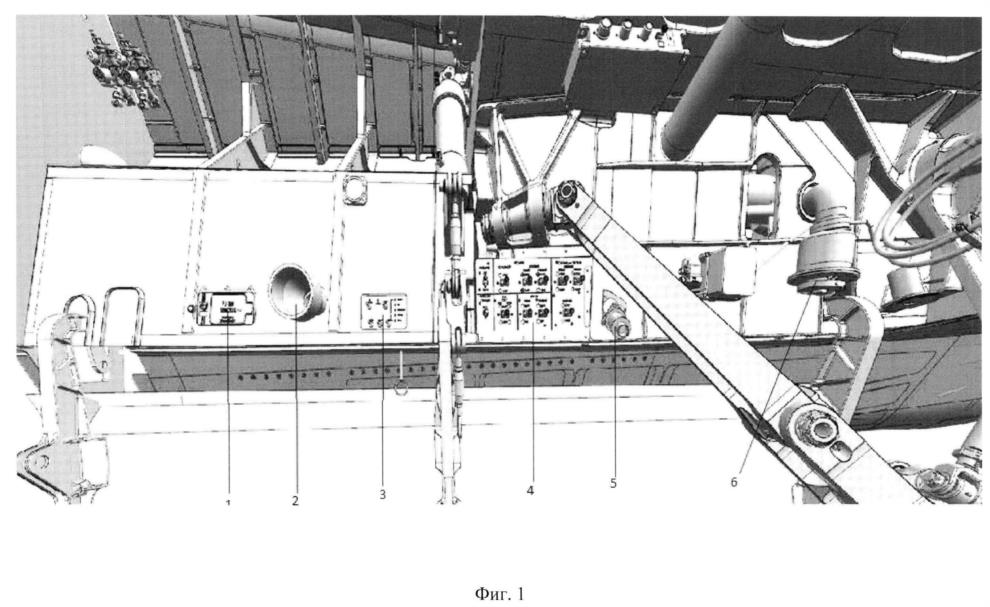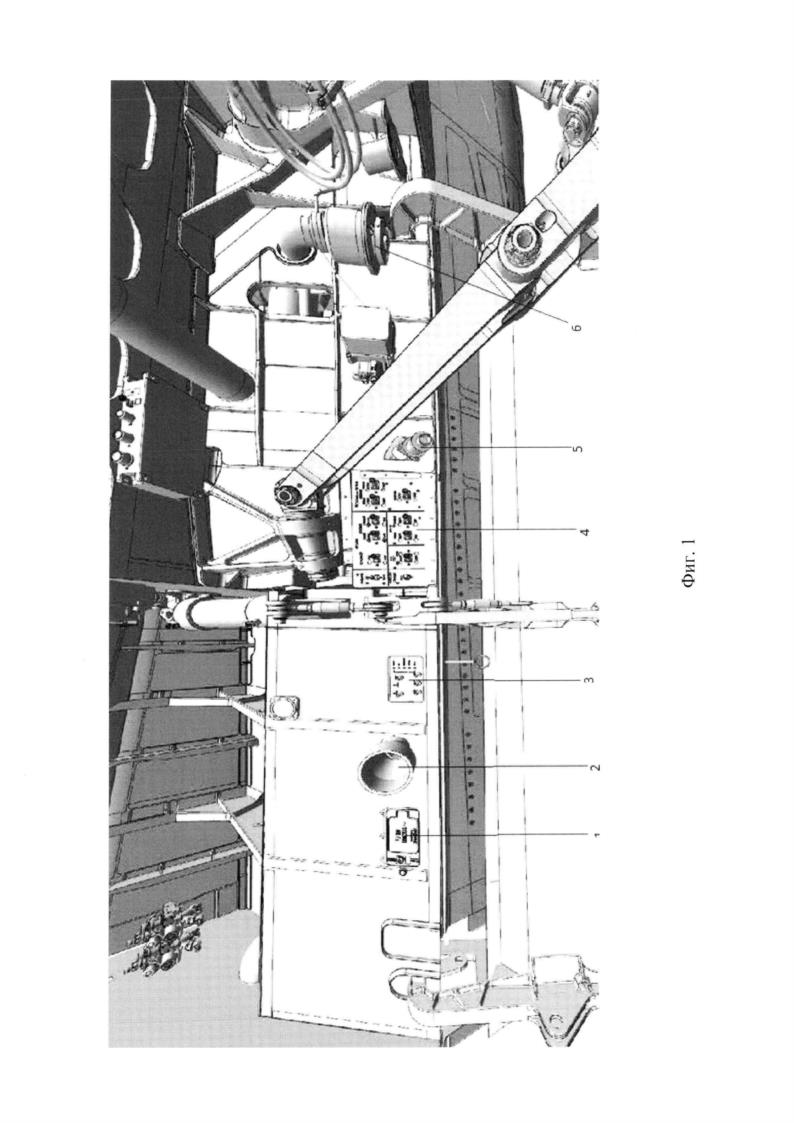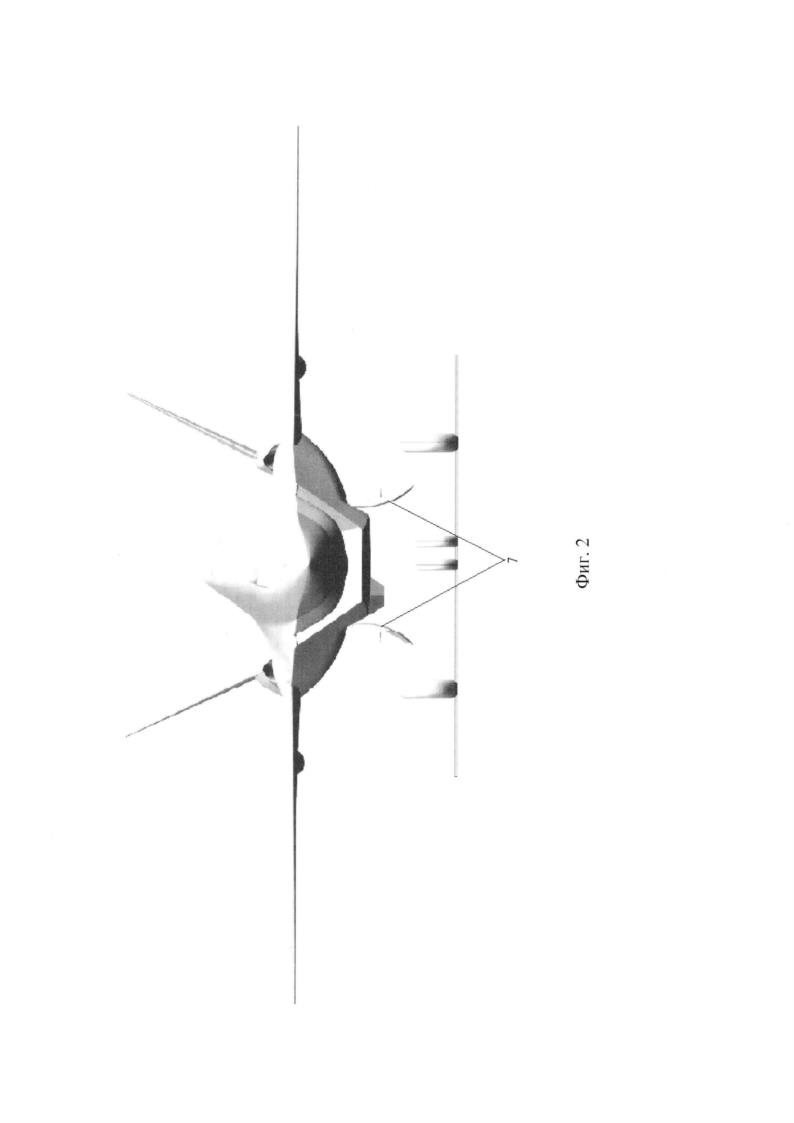(54) AIRCRAFT WITH HIGH PERFORMANCE INDICATORS
(57) Abstract:
The invention relates to the field of aviation and concerns the operational manufacturability of a multifunctional single-engine supersonic aircraft. The aircraft includes landing gear supports located in niches, hydraulic and electrical supply systems, maintenance units located in support niches, and on-board equipment located in compartments inside the fuselage. At the same time, service units for refueling with fuel and oil, connecting a ground source of air conditioning and power supply, ground preparation of weapons, control of cargo compartment doors, grounding and a ground intercom are located in the niches of the left and/or right main landing gear with the possibility of human access without using additional funds. The avionics units are located in compartments inside the fuselage behind the niche of the right and/or left landing gear in the direction of movement of the aircraft with the possibility of human access without the use of additional means and are closed with service hatch covers using quarter-turn locks for the cover fastenings. Moreover, dismantling the power plant does not require dismantling other power elements of the aircraft. Achieved is a reduction in time, increased convenience and safety of technical operation and maintenance of a light tactical aircraft. 2 salary f-ly, 2 ill. Moreover, dismantling the power plant does not require dismantling other power elements of the aircraft. Achieved is a reduction in time, increased convenience and safety of technical operation and maintenance of a light tactical aircraft. 2 salary f-ly, 2 ill. Moreover, dismantling the power plant does not require dismantling other power elements of the aircraft. Achieved is a reduction in time, increased convenience and safety of technical operation and maintenance of a light tactical aircraft. 2 salary f-ly, 2 ill.

The invention relates to the field of aviation, namely to multifunctional single-engine supersonic aircraft.
A multi-mode highly maneuverable aircraft with an integral aerodynamic configuration is known (patent RU 2400402, published 09.27.2010, IPC V64S 30/00, V64S 1/22), containing a fuselage, the middle part of which is smoothly coupled with swept wing consoles, the head and tail of the fuselage, an all-moving vertical and horizontal tail in the rear fuselage. The aircraft is characterized by the fact that the middle part of the fuselage is integrated with the wing center section and is flattened in the vertical direction, and its outer surface in the longitudinal direction is formed by a set of aerodynamic profiles with high construction heights, ensuring the placement of built-in cargo compartments inside the fuselage,
An aircraft with an integral aerodynamic layout is known (patent RU 2440916, published 01/27/2012, IPC B64D 27/20, B64D 33/02), containing a fuselage, a wing, the consoles of which are smoothly coupled with the fuselage, horizontal and vertical tail surfaces, a twin-engine power plant, characterized by that the fuselage is equipped with a bead located above the entrance to the engine air intakes and including controlled rotating parts, while the middle part of the fuselage is flattened and formed longitudinally by a set of aerodynamic profiles, the engine nacelles are spaced apart horizontally, and the engine axes are oriented at an acute angle to the plane of symmetry of the aircraft in the direction of flight.
A multifunctional aircraft with reduced radar signature is known (patent RU 2502643, published 12/27/2013, IPC B64D 7/00, B64D 27/16, containing an airframe, a twin-engine power plant and a set of on-board equipment.
A supersonic aircraft with intra-fuselage cargo compartments is known (patent RU 2583824, published 05/10/2016, IPC B64D 7/08, B64C 30/00), containing a fuselage in the lower part of which large longitudinal cutouts are made for tandemly located cargo compartments.
The technical solutions adopted in analogues do not provide a sufficient level of operational manufacturability and are characterized by increased labor intensity and duration of maintenance. There is no convenient access to the niches of the main landing gear supports (supports), where maintenance units are located. The process of installing and dismantling the engine is labor-intensive and is achieved with the use of additional devices for the upper surfaces. There are a large number of fastening elements on service hatches, which are characterized by the most labor-intensive process of opening/closing hatches, which leads to an increase in the duration of dismantling and installation of service hatch covers. The dense arrangement of blocks and assemblies on board the aircraft leads to the need to dismantle adjacent blocks and assemblies during maintenance and troubleshooting. To dismantle the power plant, partial dismantling of the power elements (frame sections) is required.
The technical problem to which the invention is aimed is to eliminate the shortcomings of aircraft known from the prior art and create a light tactical aircraft that is easy to operate and has the least labor-intensive and time-consuming aircraft maintenance operations.
The technical result of the claimed invention is to increase the convenience and safety of technical operation and maintenance of a light tactical aircraft, including troubleshooting, as well as to reduce the time required to carry out these activities.
The given technical result is achieved by the present invention. A multifunctional single-engine supersonic aircraft contains a fuselage, a wing, a power plant, a canopy with a pneumatic opening system, landing gear supports located in niches, hydraulic and electrical supply systems, maintenance units located in support niches, and on-board equipment located in compartments inside the fuselage. The aircraft is characterized by the fact that the aircraft service units for refueling fuel and oil, connecting a ground source of air conditioning and power supply, ground preparation of weapons, control of cargo compartment doors, grounding and a ground intercom are located in the niches of the left and/or right main landing gear with the possibility of access to him of a person without the use of additional means,
The aircraft is additionally characterized by the fact that the oxygen filling system, the filling system for the pneumatic system for opening the canopy and emergency landing gear, the technological connectors of the on-board equipment are located in the niche of the front landing gear, and the switchgear and contactor boxes are located in the upper part of the niche of the landing gear with the possibility of human access without the use of additional funds.
The invention is illustrated by drawings.
Figure 1 shows a view of the landing gear and aircraft maintenance units (example), located in its niche, where 1 is the connection point for a ground-based power supply source, 2 is the connection point for a ground-based air conditioning source, 3 is a ground-based weapons preparation console, 4 is a control panel. cargo compartment doors, 5 - closed engine oil filling fitting, 6 - centralized fuel filling fitting.
Figure 2 shows a front view of the aircraft, where 7 - the doors of the right and left niches of the main landing gear are presented in the open position.
The niches of the right and left main landing gear of the aircraft are closed in flight by flaps. On the ground, these doors are always in the open position. In the proposed technical solution, the doors of the right and left niches of the landing gear support open to the axis of symmetry of the aircraft, which provides a convenient approach for the specialist to the niche and makes it possible to increase the safety and convenience of aircraft maintenance.
Before performing assigned tasks, the aircraft undergoes pre-flight training, during which the specialist each time needs access to the appropriate aircraft maintenance units.
In the proposed technical solution, aircraft maintenance units (refueling engine fuel and oil, connection point for a ground source of air conditioning, power supply, grounding, ground intercom, ground weapons preparation, control of cargo compartment doors, etc.) are located in the niches of the right and left landing gear at a height , allowing a specialist to conveniently access them from the ground without the use of additional means (from a height of human height). The height interval is from 1.7 to 1.9 m. During operational maintenance, all the necessary aircraft maintenance units are located in places that do not require opening the service hatches and are not equipped with other closing elements.
Some of the aircraft maintenance units (refueling the pneumatic system for opening the canopy and emergency landing gear, refueling and monitoring the oxygen system, technological connectors for on-board equipment) are located in the niche of the front landing gear. The proposed arrangement of maintenance units reduces the duration of work and reduces the labor intensity of maintenance and increases ease of use in general.
As part of periodic aircraft maintenance, diagnostics, repair or replacement of units and assemblies of aircraft systems is required. The aircraft layout also provides for the placement of aircraft units and assemblies depending on their operational reliability and the frequency of maintenance activities.
The aircraft units and assemblies that have the greatest wear during operation and require periodic replacement or require high frequency maintenance (for example, as part of pre-flight preparation or post-flight maintenance) are provided with the fastest and most convenient access with a significant reduction in operating time. For example, DC circuit breakers are easy to access.
In the proposed technical solution (not shown in the drawings), avionics units that require a high frequency of diagnostic, maintenance or repair activities are located inside the fuselage, accessed through the service hatch behind the niche of the right and/or left landing gear in the direction aircraft movements, without the use of additional means, from a height of human height, height interval from 1.7 to 1.9 m.
The service hatch, with the specified avionics units located inside, is closed with a lid using quarter-turn locks for closing/opening. The use of quarter-turn locks made it possible to reduce the total number of fasteners by increasing the step of their installation, as well as reduce the complexity of opening/closing hatches and increase the speed of technical operations.
To carry out maintenance activities, it is not necessary to dismantle the on-board equipment units; it is enough to connect to the technological connector located in the niche of the front support. And to implement repair maintenance measures for units, it is not necessary to dismantle adjacent units and assemblies of other aircraft systems. This solution for avionics units also reduces the duration and complexity of maintenance and increases ease of use in general.
The layout of aircraft system elements, in particular the power supply system (PSS), provides a convenient approach to servicing systems during technical operation. Units of the power supply system (switchgear and contactor boxes), requiring constant inspection and monitoring, are located in the upper part of the OSH niche and have free access.
The proposed design and layout of the aircraft also allows for quick and convenient installation and dismantling of the engine. The aircraft is designed in such a way that dismantling the power plant does not require dismantling other power elements of the aircraft. Dismantling of the power plant is carried out in the “back and down” direction using a specialized trolley containing a carriage and a mechanism for engaging and transporting the engine.
Claim
1. Multifunctional single-engine supersonic aircraft containing a fuselage, wing, power plant, canopy with a pneumatic opening system, landing gear supports located in niches, hydraulic and electrical supply systems, maintenance units located in support niches, on-board equipment located in compartments inside the fuselage , characterized in that the aircraft service units for refueling fuel and oil, connecting a ground source of air conditioning and power supply, ground preparation of weapons, control of cargo compartment doors, grounding and a ground intercom are located in the niches of the left and/or right main landing gear with access to without the use of additional means, the doors of the landing gear niches are installed with the possibility of opening them to the axis of symmetry of the aircraft,in this case, the avionics units that require a high frequency of maintenance activities are located in compartments inside the fuselage, behind the niches of the right and/or left landing gear in the direction of movement of the aircraft with the possibility of human access to them without the use of additional means and are closed with service hatch covers using quarter-turn locks for the cover fastenings, and the aircraft is designed in such a way that dismantling the power plant does not require dismantling other power elements of the aircraft.behind the niches of the right and/or left landing gear in the direction of movement of the aircraft with the possibility of human access without the use of additional means and are closed by the covers of the operational hatches using quarter-turn locks of the cover fastenings, and the aircraft design is made in such a way that dismantling the power plant does not require dismantling other power elements of the aircraft.behind the niches of the right and/or left landing gear in the direction of movement of the aircraft with the possibility of human access without the use of additional means and are closed by the covers of the operational hatches using quarter-turn locks of the cover fastenings, and the aircraft design is made in such a way that dismantling the power plant does not require dismantling other power elements of the aircraft.
2. Multifunctional single-engine supersonic aircraft according to claim 1, characterized in that the oxygen filling system, the filling system for the pneumatic system for opening the canopy and emergency landing gear, and the technological connectors of the on-board equipment are located in the niche of the front landing gear.
3. Multifunctional single-engine supersonic aircraft according to claim 1, characterized in that the switchgear and contactor boxes are located in the upper part of the landing gear niche with the possibility of human access to them without the use of additional means.







